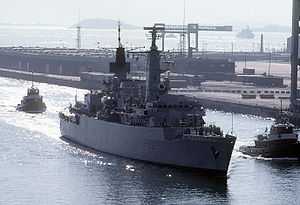HMS Brilliant (F90)
 HMS Brilliant | |
| Career (UK) | |
|---|---|
| Name: | HMS Brilliant |
| Operator: | Royal Navy |
| Builder: | Yarrow Shipbuilders |
| Laid down: | 25 March 1977 |
| Launched: | 15 December 1978 |
| Commissioned: | 15 May 1981 |
| Decommissioned: | 1996 |
| Identification: | Pennant number: F90 |
| Fate: | Sold to Brazil 31 August 1996 |
| Career (Brazil) | |
| Name: | Dodsworth |
| Operator: | Brazilian Navy |
| Identification: | Pennant number: F-47 |
| Fate: | Sold for Scrap |
| General characteristics | |
| Class and type: | Type 22 frigate |
| Displacement: | 4,400 tons |
| Length: | 131.2 m (430 ft) |
| Beam: | 14.8 m (48 ft) |
| Draught: | 6.1 m (20 ft) |
| Propulsion: | 2 shafts, COGOG 2 × Rolls-Royce Olympus TM3B boost gas turbines (54,600 shp) |
| Speed: | 18 knots (33 km/h) cruise 30 knots (56 km/h) top speed |
| Complement: | 222 |
| Armament: | 2 × 6 GWS25 Seawolf SAM launchers 4 × 1 Exocet SSM launchers 2 × 40 mm Bofors AA guns |
| Aircraft carried: | 2 × Lynx MK 8 helicopters |
HMS Brilliant was a Type 22 frigate of the Royal Navy.
Royal Navy Service
Brilliant was part of the Task Force that took part in the Falklands War, with Captain John Coward in command.[1] During the war her two helicopters were involved in unsuccessful attacking the Argentine submarine Santa Fe, and she was the first Royal Navy warship to fire the Sea Wolf missile in action when, on 12 May 1982, she shot down three A-4 Skyhawks. On 21 May HMS Brilliant came under Argentine air attack outside San Carlos Water and was slightly damaged by cannon fire. On 23 May she joined HMS Yarmouth in the chase of the Argentinian supply ship ARA Monsunen. She rescued 24 survivors from Atlantic Conveyor on 25 May. Brilliant had sailed south with a pair of WE.177A nuclear depth charges on board.[2] To avoid complications arising from the Treaty of Tlatelolco, these were unloaded to RFA Fort Austin on 16 April 1982.[3]
In 1987 she became leader of the 2nd Frigate Squadron. In October 1990 she saw the first members of the Women's Royal Naval Service to serve officially on an operational warship.[4] Brilliant starred in a BBC documentary series called HMS Brilliant - In a Ship's Company by the journalist Chris Terrill in 1994, while she was undertaking an operational tour off the coast of former Yugoslavia enforcing a United Nations arms embargo in the Adriatic sea.[5]
Brazilian Navy Service
She decommissioned from Royal Navy service in 1996 and was sold to the Brazilian Navy on 31 August 1996 and renamed Dodsworth.
F47 Dodsworth was sold for scrap and broken up at Aliağa, Turkey, during July 2012.[6]
The silhouette of HMS Brilliant is painted, with the date 21 May, on the side of Argentine Air Force IAI Finger serial number C-412. Also painted on C-412 is the silhouette of HMS Arrow and the date 1 May. These kill markings (without crossing) have to do with damage to both ships in the Falklands War, HMS Arrow being slightly damaged by cannon fire 1 May 1982 and HMS Brilliant also being slightly damaged by cannon fire on 21 May. Finger's markings were painted soon after the war; they were seen during the November 2005 multi-national Exercise Ceibo in Argentina, and still there as of 2007.
Commanding Officers
| From | To | Captain |
|---|---|---|
| 1982 | 1982 | Captain John Coward RN |
| 1983 | 1984 | Captain Michael Boyce RN |
| 1987 | 1989 | Captain Colin H.D. Cooke-Priest RN |
| 1989 | 1990 | Captain Richard F Cobbold RN |
| 1990 | 1992 | Captain Tobin D Elliott RN |
| 1992 | 1994 | Captain James Burnell-Nugent RN |
| 1996 | 1998 | Captain Paulo José Rodrigues de Carvalho BN |
References
- ↑ Admiral Sandy Woodward: One Hundred Days, page 364. ISBN 978-0-00-713467-0
- ↑ Lawrence Freedman, The Official History of the Falklands Campaign, Volume 2. Page 59. ISBN 978-0-415-41911-6
- ↑ Ministry of Defence Page 8. Retrieved 10 March 2009
- ↑ History of the Women's Royal Naval Service and its integration into the Royal Navy
- ↑ Terrill, Christopher, HMS Brilliant - In a ship's Company, BBC Books, 1995
- ↑ http://www.shipspotting.com/gallery/photo.php?lid=1604528
Publications
- Colledge, J. J.; Warlow, Ben (2006) [1969]. Ships of the Royal Navy: The Complete Record of all Fighting Ships of the Royal Navy (Rev. ed.). London: Chatham Publishing. ISBN 978-1-86176-281-8. OCLC 67375475.
- AirForces Monthly Magazine February 2006, page 61.
External links
| ||||||||||||||||||||||||||